Once every while a new product with great potential appears on the markets. Most of the time a very enthusiastic team of entrepreneurs has been working hard on the product and are very happy to see that it starts taking off and sometimes even tends to start becoming disruptive. All goes great until a competitive product enters the market with similar features but for a way smaller price. And who is the competitor? Another start-up? No, it is Amazon who identified the promising future of the product and made their own version of it. At least this happened with June. A start-up who came up with a smart oven.
June made an oven that could be controlled over Wi-Fi, had a camera so you could keep an eye on your food from anywhere and eventually was controllable via Alexa (June, 2020). By smart-device standards, June ovens were a success. They became the market leader and raised four rounds of funding of which the latest was from Amazon Alexa Fund. Then, just a year after that, Amazon launched its own smart oven with very similar features, but at half the price (Albrecht, 2019). June found itself in direct competition with the world’s largest retailer, the owner of Amazon Alexa platform and its direct investor, who had to be financially updated regularly. Almost comical, but June is not the only company with such an experience. What advantages does Amazon have that enables them to act like this? And ultimately, is this fair play? And, are all start-ups doomed to end up in a nightmare like this?
The first thing Amazon must decide on is which new product market they want to start competing on. This is best decided based on big data and Amazon really is in the right position for such a decision. They know what products are searched for on their platform, have a lot of information about prices and customer behaviour in these markets. Pointing potentially profitable markets for the coming years might even be done all automatically by artificial intelligence (Ward, 2020).
The second thing that must be done is creating the product, wherefore a lot of money is needed. This is not a problem for Amazon as they have an incredible high free cash flow, due to Amazon selling a lot of products before they pay them themselves and also the high successes of AWS, Amazon’s cloud services with high margins (Newshublab, 2020). Therefore, the cost of gathering money to develop a product is almost zero.
Then, the third step, selling the product. It should not really surprise anyone that Amazon has a competitive advantage when it comes to selling stuff. Amazon has already a huge platform with very good traffic. Moreover, they can get advertisement space for free, where other companies would have to pay big money for.
Summarizing, Amazon gets Market research, capital and Marketing & Sales almost for free. At least they pay way less than other companies like the start-up June does. Therefore, Amazon can easily undercut their competitors in the fourth section: price. But it goes even deeper. Amazon can easily sell products without profit or even at a loss (for a time) to eliminate competition.
These things all add up to an unfair way of competing and, although I admire how smart Amazon plays it, I think it is time to probably split up Big Tech firms like Amazon to avoid scenario’s like these. Business Insider posted just today a short article about the fact that this debate is alive in the American politics at the moment of speaking (Hamilton, 2020).
Before I leave you guys with some questions to think about, I’ll share a screenshot I took from a YouTube comment section, that shows that June is not the only company that is victimized (TechAltar, 2019):

What do you guys think about circumstances like these? And what would be the solution according to you?
I look forward to hearing from you and like to thank you for reading this blog post.
References:
Albrecht, C. (2019, September 26). Amazon Announces its Own Alexa Enabled Smart Oven. The Spoon. https://thespoon.tech/amazon-announces-its-own-alexa-enabled-smart-oven/
Hamilton. (2020, October 6). Democrats and Republicans are tussling over whether big tech should be broken up, according to a leaked GOP memo. Business Insider. https://www.businessinsider.com/democrat-republican-antitrust-break-up-big-tech-2020-10?international=true&r=US&IR=T
June. (2020). June Oven. June.Com. https://juneoven.com/the-oven
Newshublab. (2020, January 31). What is Amazon’s tiny profits, explained. https://newshublab.com/index.php/2020/01/31/what-is-amazons-tiny-profits-explained/
TechAltar. (2019, November 7). Amazon’s playbook for crushing startups [Video]. YouTube. https://www.youtube.com/watch?v=ojGveiE51Hk
Ward, M. (2020, January 2). Amazon: The Company Consuming Consumers. Matt Ward. https://mattward.io/amazon-the-company-consuming-consumers/


